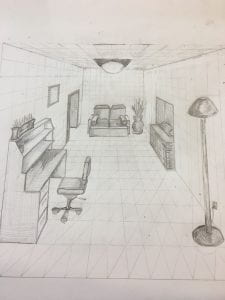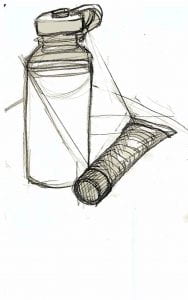






To begin creating my journey reimagined in the context of a new planet, I returned to each location from my original excursion. I wanted to find obscure perspectives at each place, while conveying a sense of curiosity and uncertainty about a particular object or landscape. I noted the physical characteristics of each spot, fixating on ones that would seem unusual to an alien. I also maneuvered my point of view to understand the emotions my scenes would provoke. Lastly, to conclude the research aspect, I thought about the various combinations of the element/principles and compositional tools I could apply to each sketch. with every sketch, I attempted a new compositional tool such as canting, framing, or worms view.
In my final work, my individual frames demonstrate a focus on compositional tools to project sentiments of curiosity, uncertainty, and observation. I use the tire as my object of intrigue as the concentric circles and unique texture make it an odd object. I used the close up view to give the wheel emphasis, while providing a sense of depth to my background. My second scene uses the frame within a frame composition. Texture also was a major influence in my work as the two wooden structures were very similar, yet possessed slight differences. In addition, the feeling on uncertainty is conveyed effectively by the narrow view of the street. Personally, I felt a little creepy and unsure myself as I peered through the small gap into the open space on John and Anne Glenn Avenue. My third situation had me focus on the extreme angle. The metal railing was an affective contrast between the other textures; however, the height was a little overdramatized. I added the hand after the critique because it helps direct the viewer to focus on the feeling and texture of the rail. Sensory input would be a major component to discovering a new planet. I continued adding myself in my next drawing, but this was to emphasize the aerial view of the cup. In this frame, the cup is an out of place object in the outside context, so I used light circular lines to focalize it. Furthermore, I attempted to use the natural direction of the step to create the golden triangle composition. My final destination was in the Architecture building, where the ceiling is composed of various lights. The clean symmetry of the spotlights fascinated me, as did there abstract angling.





This exercise had me focus on decision making when drawing from observation. I had to decide what to include and exclude. I chose to have people in two of these drawings because they added a candid anesthetic, for the concept of sitting outside doing work is a very relatable and understandable activity.

These practice exercises help induce quick sketches based on simple shapes. Initially, I had only 30 seconds which increased to a minutes, and finally 3 minutes. In the first sketch, one can see distinct use of circles, ovals, and lines to create a basic outline. In the second sketch, I lost sight of the accurate angles of my hand; therefore, when looking at the third and longest practice sketch, it is evident that I marked the finger angles and locations in.



This is a more detail practice still life based on my. smaller sketches. I used triangulation to achieve accurate positioning and sizing. If I were to improve upon this exercise later on, I would add more details and more contrast with smoother shading.
